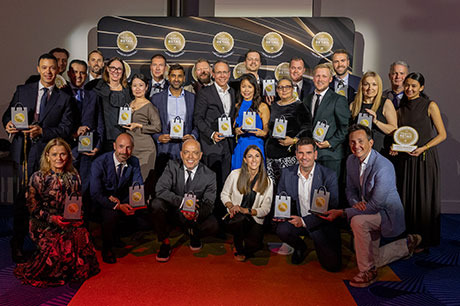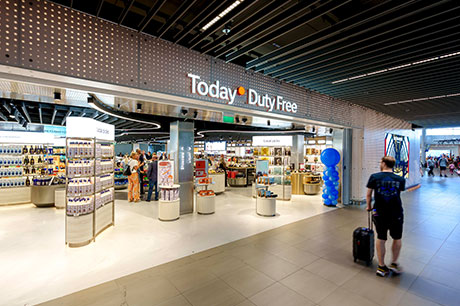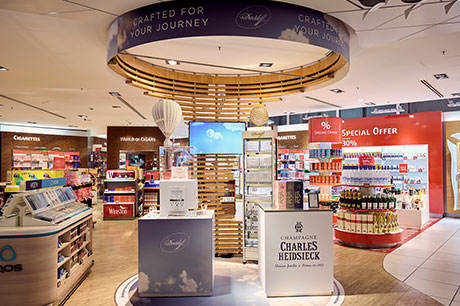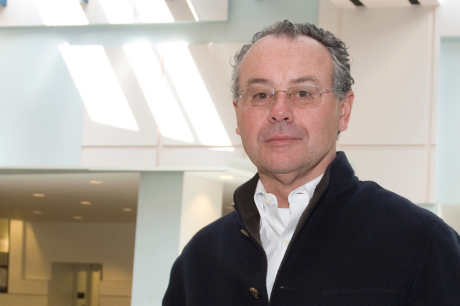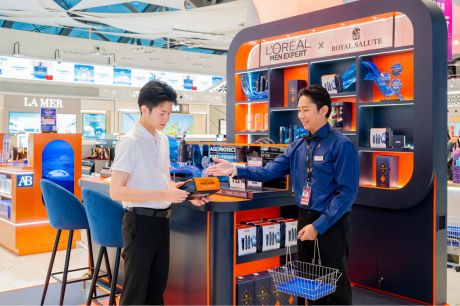Asia Pacific air travel recovery “story of two halves” – OAG Asia Aviation Head
By Faye Bartle |

The ‘Asia Pacific Travel Outlook’ session at the 2023 TFWA Asia Pacific Conference in Singapore. Photo: TRBusiness.
The outlook for air travel in Asia Pacific was discussed in detail at the TFWA Asia Pacific Conference in Singapore last week.
The 45-minute ‘Asia Pacific Travel Outlook’ session, on Monday 8 May, featured ACI Asia Pacific Director General Stefano Baronci and OAG Aviation Head of Asia and PATA Executive Board Member Mayur Patel, delivering a deep dive into the current state of play and what the future holds, with an keen eye on emerging destinations, the preferences of younger travellers, and how post-Covid travel is set to evolve.
Baronci was first to take the mic. Reflecting on the pace of the return of air traffic in the Asia Pacific region, compared to Europe and the US, he highlighted the concept of competition stating: “How can we make sure that, through the right partnerships, we can gain a competitive advantage versus where we are today”.
“It’s a long way to recover from where we were in 2019 – from the perspective of the airport operators,” he said. “During the last 10, if not 11, quarters, airports operators have reported losses in terms of EBITDA margins and net profit margins so there is a risk we have to manage, and this risk has translated into a loss of passengers. But 2023 is the year when we will see this situation changing.”
He went on to describe how internationally there is a long way to recovery (the last time Asia Pacific recorded a comparable level of traffic to North America and Europe was in 2012 with 1.7 billion air transport passengers) and that seat capacity is lacking.

ACI Asia Pacific Director General Stefano Baronci. Photo: TFWA Press Office.
“This is where the opportunities really are,” he said. “Opportunities that we will realise in 2024 into a full recovery.”
“The path and pace beyond recovery will be faster in Asia Pacific, along with the Middle East, compared to other regions, both in terms of passengers and cargo,” he continued.
“Research shows that some key aviation markets in the Asia region will be leading in the future and will be the fastest growing markets in the future – along with the usual suspects of China and India.”
He singled out Indonesia, which is anticipated to be the fastest growing market globally by CAGR (2019-2041) with a 6.3% share of passenger traffic, followed by India (6.1%) and Vietnam (5.6%). The Philippines ranks fifth (4.9%) while China ranks eighth (4.5%).
“Asia is recovering,” he stressed. “And Asia is fundamentally based on domestic travel. In China, we rely very much on this core business but for the rest of the countries, it’s the international passenger who brings the money. And according to research by McKinsey, international passengers spend 10 times more than domestic passengers.”
He reminded delegates of the perils of becoming “complacent” with the fact that domestic travel is recovering and that there is still work to be done to ensure that connectivity is facilitated.
He also highlighted the spending power of the low middle classes and how relatively modest increases in air fares can price these passengers out of the travel experience. Putting that into perspective, he flagged how in 2022 air fares in the region had increased by 30% versus Q4 2019, on average, at an international level.

A slide presented by Baronci showing the share on non-aeronautical revenues (2013-2021) at airports in Asia Pacific versus the world. Photo: TRBusiness.
Zooming in on commercial activities at airports in the region, he said: “We cannot really say what the consumer will be in two to three years’ time. We are still in a period of major adaptation and transformation. From the airport’s point of view, non-aeronautical business is key. I want to stress the point that from the regulator perspective, most of the time the airport is not in a position to cover the full cost. It is the regulator that is expecting the airport to compensate its income from the non-aeronautical business, so this is why the commercial aspect becomes so critical and this is why we need some guarantee in terms of the income to cover the capex [capital expenditures] and opex [operating expenditures] in the long term.”
He pointed out how there are exceptions in the region, such as Singapore, where the commercial business is well beyond the typical 50/50 non-aeronautical versus aeronautical ratio, but that generally speaking there is a “huge margin for improvement” across Asia Pacific.
![2023-TFWA-Asia-Pacific-Conference_Asia-Pacific-Travel-Outlook_Photo-TRBusiness[1] – TRBusiness Asia Pacific Travel Outlook session at the TFWA Asia Pacific Conference in Singapore. – TRBusiness](https://d24chjhol3kq77.cloudfront.net/trbusiness.com/wp-content/uploads/2023/05/2023-TFWA-Asia-Pacific-Conference_Asia-Pacific-Travel-Outlook_Photo-TRBusiness1.jpg)
A slide presented by Baronci showing the regulatory threats and opportunities in travel retail, outlined by ACI Asia Pacific. Photo: TRBusiness.
Next, Patel moved into the spotlight to present insights on the changes that have taken place over the last three years, and how the industry is adapting and moving forward in the recovery trajectory is it facing today.
He said that the region’s recovery is a story of two halves. “You have different re-opening profiles in the region, where you had Southeast Asia, South Asia and Australia as the first wave of reopening beginning in April 2022. In January 2023, we saw Northeast Asia open and that’s slowly building back the capacity and we look at how that will change the way people travel, the way they think about travel and how they consumer travel products along the ecosystem.”
OAG data suggests that 2024 is when the region will see a full recovery.
“We will see patches of capacity rebuilding along the way,” he said. “Corporate demand is coming back but we estimate that it will be about 25% less [than before the pandemic] as the new normal.”

OAG Aviation Head of Asia and PATA Executive Board Member Mayur Patel. Photo: TFWA Press Office.
Patel announced that OAG will be working with ACI Asia Pacific to devise policies to address fragmentation in the region, with governments being brought around the table to discuss the next potential crisis and and to formulate a crisis management plan.
Trends on the radar fuelled by pent-up demand include: the rise of bleisure travel; people travelling at different times of the year according to their generation bracket; network carriers versus LCCs; and the emergence of full-service carriers with LCCs as subsidiaries and how that will play out in the next five to 10 years.
He also highlighted the importance of connecting the traffic flows at the airport and this impact of this on getting “the best return as a duty free operator”.
He drew upon a case study of Doha and Qatar Airways offering Avios customers instant tier points for their flights at the time of check-in, which passengers can use when transiting in Doha at food and beverage outlets and duty free shops.
“This is a great innovation using digitalisation and the customer experience to deliver goods and services in real time.”

The packed audience at the 2023 TFWA Asia Pacific Conference in Singapore. Photo: TFWA Press Office.
Patel also referenced that domestic seat capacity in Asia Pacific is currently at 98% of the 2019 total, but that international seat capacity is a different story, due to a variety of factors.
However, OAG data shows that seven out of the 10 busiest international routes are in the Asia Pacific region, which shows “how important Asia Pacific is in the grand scheme of things”.
“Consumers will continue to search for new experiences,” he said. “I think Asia Pacific provides a diverse range of experiences that one can have whether it’s a beach, city or jungle. Pent up demand will be staggered in different ways as different regions have different profiles. In Southeast Asia, Indonesia has around 30% and China has around 18% of total capacity so these two markets are a very important part of Southeast Asia’s recovery.”
He mentioned how India is in its “infancy stage” currently but in five to 10 years’ time we will “see some traction” in that marketplace.
“International traffic recovery is in its early stages, as we have heard earlier on,” he added. “We cannot overlook the fact that China is primarily domestic, but it has a very strong potential for international travel moving forward.”
![OAG-Aviation-Head-of-Asia-and-PATA-Executive-Board-Member-Mayur-Patel[1] – TRBusiness Asia Pacific Travel Outlook session at the TFWA Asia Pacific Conference in Singapore. – TRBusiness](https://d24chjhol3kq77.cloudfront.net/trbusiness.com/wp-content/uploads/2023/05/OAG-Aviation-Head-of-Asia-and-PATA-Executive-Board-Member-Mayur-Patel1.jpg)
Patel ended his presentation by sharing the top five trends to watch in terms of the Asia Pacific travel outlook. Photo: TFWA Press Office.
He highlighted they key role of LCCs in opening up new destinations and offering more choice for travellers.
“We see Bali and Indonesia as key travel destinations –Vietnam, Thailand, South Korea and Japan are also key destinations that people are going to.”
He called upon the audience to look toward catering to the next generation clusters of travellers – including Generation A – and name-checked several social trends impacting travel to consider building into marketing plans as follows: YOLO (You Only Live Once – the group that wants to engage in the experience or moment as it is happening: FOMO (Fear Of Missing Out – social pressure to be in the right place with the right people); and JOMO (Joy Of Missing Out – the group that likes to live in the present moment).
Top five trends to look out for are: how new destinations are on the upswing (covering how people discover new destinations through social media and that travellers are planning to visit lesser-known places); how people are moving from seeing to experiencing (in pursuit of unique experiences); how travellers are now seeking more control (by cross checking information and reaching reviews before booking); how travel is seen as a means for personal growth (by travelling with unknown people in larger groups and embarking on adventure travel to help them present themselves as their ‘superior self’); and finally book now, pay later (to fast-track dreams into reality).
READ MORE: ‘Patience needed until passenger traffic restores,’ urges Tax Free President
READ MORE: APTRA Exchange spotlights emerging opportunities to watch in Asia Pacific
Winners revealed: Global Travel Retail Awards 2025
TRBusiness is thrilled to reveal the winners of the 2025 Global Travel Retail Awards, which...
M&M’S and Crocs unveil limited-edition collection fusing fashion and fun
Mars Wrigley International Travel Retail is debuting the first-ever M&M’S collaboration...
Valentino Beauty debuts Anatomy of Dreams collection at Dubai Duty Free
L’Oréal Travel Retail and Valentino Beauty have introduced the Anatomy of Dreams fragrance...
-
 Asia & Pacific,
Asia & Pacific,Winners revealed: Global Travel Retail Awards 2025
-

-


In the Magazine
TRBusiness Magazine is free to access. Read the latest issue now.

 Trbusiness. The travel retail Trbusiness. The magazine for global retail and duty free professionals.
Trbusiness. The travel retail Trbusiness. The magazine for global retail and duty free professionals.